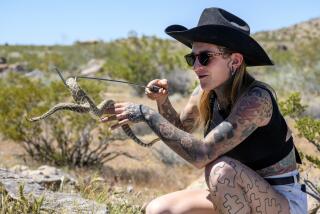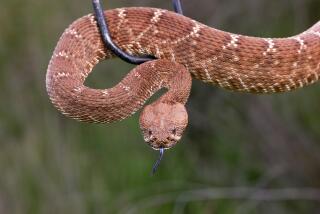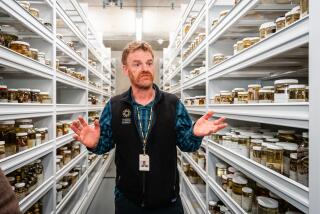Putting a Value on Lives--Ours and Theirs
- Share via
Last week, a false spring issued across the county at a time when, traditionally, rain is pouring. For us humans, this meant summer clothing, sun on our skin and the usual increased activity out of doors. The beaches and bike trails were hopping, the tennis courts busy. Interested looks and smiles passed between people of similar age and opposite gender, hormones simmering in the warmth. Premature as it was, this little faux came as a welcome reminder that winter--mild as it has been thus far--will soon be coming to a close.
My domestic animals sensed the change, too. The big dogs took to lumbering after rabbits, barking with recharged enthusiasm at the UPS man, a patient fellow named Michael who does his best to ignore their bluff. Eddie, the indoor dog, developed a new talent that my brother identified as “method begging,” in which the dog recalls the traumas of his puppyhood in order to bring more pathos to his begging expression. Everybody had a new angle.
The wild animals of our region also enjoyed the weather. At night, the coyotes of Laguna Canyon sang with a volume and energy unheard in recent months. Mockingbirds, sparrows and bushtits cavorted loudly, even though it will be several weeks before they get down to the actual business of mating and making nests. Mosquitoes hatched out--big ones droning through the twilight sky.
The fence lizards came out in force, both the adults with years of life behind them and last fall’s hatchlings, which are now almost doubled in size. Lizards are the only animals I know that can find sun faster than a tourist. They napped on fence rails, shot across asphalt to nab the newly active ants, dangled, darted and delighted in the woodpile.
In the mandevilla vine by my porch, a small web about the size of a playing card supported several hundred tiny hatchling spiders I could barely see, let alone identify. At first, I thought they were seeds. When I blew on the web, the seeds grew almost invisible legs to scurry up and down the silk to safety, though only moving about an inch. Then their legs folded back and they looked like seeds again. Within a day, the black ants had found the web and were gingerly negotiating its glossy byways, carrying away meals by the mandibleful.
Confronted by this resurgence of the living, the observer couldn’t help but feel an uplifting of spirit. For the better part of the first day, I went about my business capaciously reassured that life is good, life is sacred, life is holy. I wanted to gather all these things into my arms, carry them inside, seat them around my table and put on the feed bag for them. I wanted to listen to the smallest problems of the field mouse, to counsel, if I could, the two hummingbirds who had been dueling ferociously over access rights to the lavender blossoms. I wanted everybody to love everybody else.
Noonish, my brother Matt lifted a sheet of plywood from the woodpile, to uncover a 40-inch red rattlesnake curled up beneath it. After locking the dogs safely away, we flipped over the wood and beheld the serpent. She (only a guess) was coiled up in almost perfect symmetry, roughly the diameter of a dinner plate. She didn’t move. Her eyes were open, because snakes don’t have eyelids to close. Matt and I gazed down at the thing and wondered what to do with it.
“Nine rattles,” I noted.
“Pretty capable looking,” said Matt.
“We could make a belt out of it, but it seems like a waste of life.”
“They don’t taste very good either. Sort of like a really old catfish.”
“All those ribs.”
“Probably been here all winter. Just made it up to the top for the sun. It’s too sluggish to even rattle.”
“I worry more about the dogs than about us. They’re dumb enough to walk right into this thing.”
We used a snake hook to raise and lower the reptile into an empty trash can. She barely uncoiled during the airlift. She hit the plastic bottom with a thud, then offered a desultory rattle of about two seconds. Her rattles sounded waterlogged.
“Well,” said Matt, “first we had a rattlesnake in the woodpile. Now we’ve got a rattlesnake in a trash can.”
“We’ll have to think about this one.”
There’s nothing like the discovery of something dangerous in your village--a rattler, a rogue lion or leopard, a cobra, a scorpion--to make one think a little harder about life and what it is worth, and what it is not worth.
It was clear to me that killing the snake for self-defense wasn’t an altogether truthful concept because rattlesnake bites are, for humans, at least, rarely fatal. However, leaving it in the woodpile to revitalize in the coming spring seemed both foolhardy and irresponsible to my dogs and visitors (some with children) who come up here almost weekly.
I spent the early afternoon contemplating the ethics of humankind as we interact with the other species on this planet, wondering if we, as a race, have been egregious in assuming without much thought--until recent times--that nature’s bounty is simply there for us to utilize, displace or liquidate as we see fit.
Certainly most of us agree that it is both ethical and necessary for human beings to eat some plants and some animals in order to sustain our lives (animal rights activists would disagree, claiming that a living animal should not be killed and eaten, but a living plant should be). So, ruling out the rattlesnake as food, what is my ethical obligation to her, as a genuine threat to the health and welfare of myself and the people, dogs, cats, horses, etc., around me?
Even under minimal scrutiny, the “life is sacred” argument doesn’t cut much ice in our day-to-day world. Few of us balk at swatting a mosquito taking a blood meal from our flesh, or mourn the termites we exterminate. Only a fool would protest eradicating cancerous cells or the AIDS virus--both of which are very much alive. We have accorded some lives a lower standing than others, cancelable on demand.
Thus, we find ourselves in the position of judging--almost strictly on the basis of self-interest--what life should be taken for protection or for food, what life qualifies to be left alone, preserved, even worshiped. It is difficult to put a value on life, but we, as humans, if we think about it, are asked to do it every day.
Happily, there was a workable compromise with regard to the rattlesnake, in a way there might not be with a man-eating tiger or a rogue grizzly bear. We simply dumped the sleepy reptile into a six-pack cooler, took her to the other side of the mountain and let her go on a hillside where, we hope, she will bother no human and no human will bother her.
Of course, the snake will eat her meals of mammals and lizards and defend herself against predators, with none of the foregoing introspection. She has a cleaner sight line than we do. Watching her slide beneath the prickly pear, I was thankful that there is room in this county--at least for now--for both of us to eke out a living.






